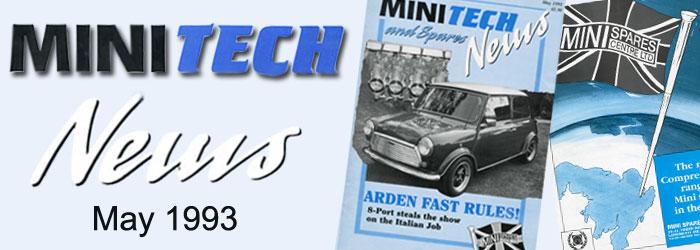VALVE GUIDE MATERIAL ADVANCES
 More and more Mini owners are fitting modified, lead free cylinder heads to their cars. Due to this trend Mini Spares have investigated prolonging valve and guide life, as accelerated wear is the main problem when going this route. The problem is magnified when using modem performance cams with high lift, short duration profiles - particularly when used in conjunction with high lift rockers. Obviously using the Mini Spares roller tip rockers alleviates the problem quite considerably, but not for those running standard rocker gear.
More and more Mini owners are fitting modified, lead free cylinder heads to their cars. Due to this trend Mini Spares have investigated prolonging valve and guide life, as accelerated wear is the main problem when going this route. The problem is magnified when using modem performance cams with high lift, short duration profiles - particularly when used in conjunction with high lift rockers. Obviously using the Mini Spares roller tip rockers alleviates the problem quite considerably, but not for those running standard rocker gear.
The material originally used by Leyland ST was phospher-bronze, referred to by many as "hidural". Although a very good bearing material it is relatively soft - suffering quickly from the side-thrust moment of the valve stem caused by the rocker arm sweeping through its arc. After a relatively short-time, the guide becomes worn and allows excessive amounts of oil to drain down between valve and guide. This causes accelerated oil consumption (the "blue cloud" belched out on over-run) and more detrimental - contamination of. the combustion charge. This contamination effectively lowers the octane rating of the fuel used. Highly undesirable, particularly in cars using high compression ratios. Inevitably detonation -or "pinking" - occurs which can destroy pistons quite quickly.
The question was - which material to go for - bearing in mind its application and the fact that they have to be affordable. Exotic materials are no problem, but the prices are totally prohibitive.
A number of tuning companies in England have been importing guides from the States for some years. Despite being somewhat costly after all duties, etc., are paid, they 'seemed to be pretty good - so a look at these was the first step. Appearance showed them. to be some silicone-brass alloy. Questions were asked of those using them - overall the answers put them in a very good light. However, there was still the cost problem, and their reluctance to be easily reamed to the correct finished size. It wasn't that this was difficult to achieve, just that the material was very hard on reamers! Good reamers are expensive at one every 6 heads.
Further investigations were carried out by chemical analysis, and more enquiries to people in the performance market. Then consultations with guide manufacturers and finally foundries that produced alloyed-bronze. A specification was decided upon and the first batch produced. These were duly tested. In 99 out of 100 instances they were proven · to be excellent, but when used with certain valves from a particular manufacturer now and again the valve picked up in the guide. The problem was duly analysed and an ever-so-slight material mis-match was discovered.
Further discussions with the foundry provided the answer, and a special mix was decided upon. This mix is used in the racing Jaguar heads, Aston Martin's, and other - erm - exotica! A little more costly, but at least we are happy that all of our objectives have been reached - greatly extended life, comparatible with all known valve materials (treated or otherwise) and will work with all usual fuels used, without noticeably increasing valve stem wear - all at the same price to the customer as the original "hidural" guide set.
Keith Calver •
Importation rules regarding vehicles are very specific: Only those over 25 years in age may be brought in to the USA without compilance to Federal Motor Vehicle Safety Standards (FMVSS).Author
admin

